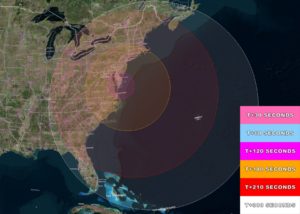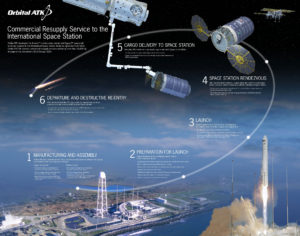
10/11/16 Update: Due to Hurricane Nicole and possible impacts of this mission’s tracking station on Bermuda, the launch has been postponed to Sunday, October 16.
Residents across much of the eastern United States will be able to see a rocket launch from NASA’s Wallops facility in Virginia during the upcoming OA-5 mission launch slated for 8:03pm on Sunday, October 16.
The Orbital ATK Antares rocket launch for this mission, code-named OA-5, will bring Orbital ATK’s Cygnus spacecraft into space. Cygnus will carry approximately 5,290 pounds of supplies and science experiments for the International Space Station (ISS).
Cygnus will be launched into orbit using Orbital ATK’s upgraded Antares 230 launch vehicle from Wallop’s Regional Spaceport Pad 0A on Wallops Island, Virginia at NASA’s Wallops Flight Facility. The Antares 230 vehicle features all new RD-181 engines. This will be the first major launch at Wallops since the October 2014 accident.
Shortly after 6:22p on October 28, 2014, Orbital ATK’s Antares rocket suffered an anomaly during launch from the same pad which resulted in the loss of the rocket and its cargo and damage to the launch pad. No workers or members of the public were injured as a result of the accident. This new launch, Orbital ATK’s first since that accident, incorporates learnings from those accident findings. An independent NASA investigation concluded there was an explosion in the liquid oxygen turbopump in one of the two AJ-26 engines, designated E15, in the vehicle’s first stage about 15 seconds after ignition.
After a successful launch into low-Earth orbit, the Cygnus spacecraft will use its maneuvering capability to transport the cargo from a low parking orbit to the ISS where it will be grappled by the station’s crew using the station’s robotic arm and berthed to the station. After the cargo is removed and any disposal items are added, Cygnus will depart from the ISS and begin secondary payload missions.
For the OA-5 mission, Cygnus will carry the Saffire II payload experiment to study combustion behavior in microgravity. Data from this experiment will be downloaded via telemetry. In addition, a NanoRack deployer will release Spire Cubesats used for weather forecasting. These secondary payload operations will be conducted after Cygnus departs the space station.
You can view the launch along most places in the eastern US away from clouds and light pollution; the area from New York City through New Jersey south into the North Carolina Outer Banks will have the best view. Those closest to the NASA Wallops Visitors Center in coastal Virginia will enjoy the best sound and light show from the launch.
We will have live coverage from the Wallops spaceport for this launch in October; be sure to follow us on Twitter for special coverage: http://www.twitter.com/theWeatherboy
